Model Engine Gallery Page 19
Click on the images to view them larger size.
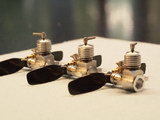

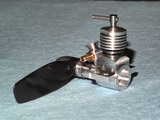
|
These examples of the Richard Gordon Nano 0.1cc Diesel were completed by Richard Klopp. Richard changes the needle valve from a very Cox-like design to what he terms a modified Little Dragon design NVA. Richard tried the spring starter which appears on the plans (Tip: Members! Check Your Cookie!), reverting to a piece of rubber tubing over a spinner, flicking it through his fingertips. That is one method I've never heard of before, but I can see how it works, and knowing the edge on those tiny Cox 3 x 1.5 props which Richard is using, it seems like a good idea for which his fingers thank him. We have concluded that when it comes to tiny engines, especially diesels, technique is everything. There are a lot of techniques which work, most involving a sharp, fast spin of the prop. Richard's approach seem rather gentle, but I never argue with success. Running a Nano is a big thrill. So as they say today, running three of them must be totally "awsome". To see the engine in action, Richard has supplied the following YouTube links. The videos are short, but worth watching. I final got one of three "Gordon Nano" 5mm x 5mm bore/stroke engines running today. You can see a couple of short videos on youtube. In this video, the pitch is approximately middle C, which corresponds to about 16,000 RPM.
My wife Hilary's fingertip cameos in this video.
|
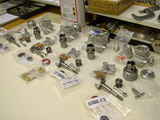
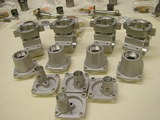
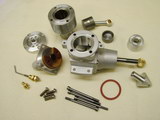
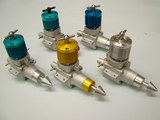
|
Regular readers of these pages and the Model Engineer will recognize the characteristic craftsmanship of these scaled-up 5cc versions of the ETA .15 team race diesel. They are the work of Tug Wilson (UK), who has become the master of building perfect, scaled up replicas of popular English diesels. I've raved over Tug's work on these pages before in the form of his 5cc ED Racers and 5cc Super Tigre G32. Tug reports that they took just over four months to build—first cut to running—ignoring all the time which went into research, planning, and preparation of the drawings. The Mk 1 and Mk 2 will be featured some time this year in Model Engineer in a full build article along with drawings. Tug made four versions of the engine. One Mk3, two Elites—one of which tug says might at th a mighty big "might", grace the noze of a scaled up Tigress team racer, for nostalgias sake—and one Elite Mk2. As usual all have been machined from solid on Tug's old Linley mill and on the Myford S7. The material used for all was HE30 aluminum, save for the con-rod which is Alumec 89. Liners are from EN1a, while the pistons are made from Meehanite cast iron, lapped as per the writings of George Aldrich. Tug's crankcases were bead blasted suing a friend's equipment, but he now has his own cabinet for future engines All of the Big ETAs started easily and ran well using a 12x5 wood prop and 'sport' fuel. Tug keeps the revs well down for the initial runs, which is the recommended procedure for lapped fit engines. One contra piston was a bit loose so Tug "grew" it by 0.05mm in diameter by heat treating and re-lapping. Apart from this, and a tightish piston at TDC on one of the Elites, soon lapped out with some 'Diamantine', no other fettling was required. The Elite Mk 2 has a particularly lovely diesel 'bark'. Currently, Tug is working on a 2.5cc Stockton and Jehlik, but after that, has decided he's going to take a break from machining for a spot of R/C sailing and the need to scratch a yacht building itch. |
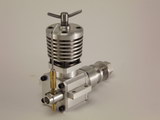
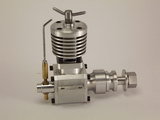
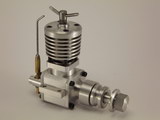
|
The Naylon Viper has been one of our more popular plans sets due in part to the simplicity and elegance of the design, not to mention that is is a practical engine, capable of good performance. It is also not a beginner level engine, nor one that can be built quickly, but it certainly is eye-catching to all who see it and appreciate 2.5cc team race diesels of times past. The example seen here is probably the first completed, plans-built example. It was built by Charlie Stone (Australia) who sent these photos, still warm from its first rich run of only a couple of minutes. Charlie reports that it feels good and starts as easily as his Olivers, is which is to say, very easily! The plans show a unique "blunt end" needle which performs fuel metering by exposing a lateral slot along the center of the spraybar. This is unusual to say the least, so figuring that he'd like to see how it is capable of running before embarking on any grand adventures, Charlie has built his with a conventional pointed needle. But he is interested to see how the blunt one will perform, so will try that after the engine has some more running and its performance with the conventional NVA has been established. |
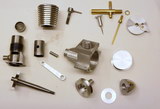
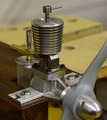
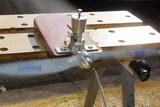
|
This Sparey 5 (aka the Aeromodeller diesel) was built by Keith Beaumont (UK). Keith reports that initially, he could get it to fire, but not run. Deciding that the piston/liner fit was the problem, he made a new piston and contra-piston to achieve that perfect bouncy compression feeling. In doing this and checking fits etc, he discovered that the tight fit of the cylinder into the crankcase prevented correct seating of the cylinder resulting in an out of square relationship between the two. While small, it was enough to loose some crankcase (primary) compression, which would lower the ability of the engine to transfer a new charge. This problem was corrected by careful scraping and may have been a significant part of the original problem as when reassembled, the engine started and ran on the second flick! It now swings a 16x8 nylon prop at 4000 RPM and is enjoying a stint of rich running-in. |
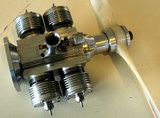
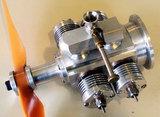
|
More engines from Dean Clark (NZ). The top one was his 6th engine and first of his flat-fours. Dean used Webra Mach-1 cylinder liners with modified pistons. He says they are timed so that the opposed cylinders fire simultaneously, while each pair (of pairs) fire alternately. This requires a four-throw crankshaft which Dean machined in one piece, using split big-end connecting rods. As there is no apparent stagger in the cylinders, Dean must have offset the conrods from the cylinder axis—an approach which worked fine for Lew Ross and his commercial Ross-Power two, four, and six boxer engines. The lower engine, his 7th, is another Webra Mach-1 cylinder based flat four. This time, he made the pistons to fit the liners and used a plenum chamber to feed the inlet valves. Effectively, Dean's boxers are coupled simultaneous twins, meaning that the pair of crankcase cavities must be isolated from each other as primary compression will be out of phase by 180°. This is not all that simple to achieve, while keeping friction to a minimum. |
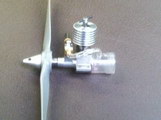
|
Dave Miner (Seattle USA) continues to refine his small diesel making techniques. This little .020 cuin FRV is his latest. Dave reports that is swings the 5.5x2 prop as seen here at 10,000 rpm on standard (1:1:1) fuel. As might be expected, it is a fuel miser and will run three minutes on the backplate mounted tank. The engine is however sensitive to the fuel level in external tanks and will refuse to draw fuel "up-hill" as the level in the tank drops below the needle. This is hardly surprising when you consider the tiny pressure differential produced by our engines (see Dave Girke's second two-stroke book). |
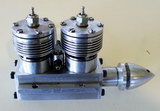


|
These twins are the work of Dean Clarke (NZ). The one at the top was the first engine he made. It uses cylinder liners from a Russian Mk 12B, but all the other parts were made by Dean. The crankshaft is untreated 4041 steel, made in two parts. The conrods are 2024 alloy, with everything else machined from 6061 stock. Dean thinks that it runs well considering that his "eyeometer" was out of calibration on the inlet port timing. The other twin is an updated version of the first, constructed after Dean read about Tug Wilson's 5cc ED Racers. Tug's work on the cases inspired Dean to see how well he could round out the crankcase bottom and do a little sand blasting to even out the finish. Like his first twin, it uses Mk 12B cylinder liners, lapped out to take shop-made pistons. |